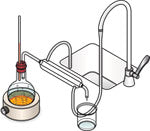
Use the following symptoms to determine the possible cause of problems with your water quality – these symptoms can all be felt, smelled, tasted or seen. Watch out… some of the symptoms may indicate serious problem!
A. Sense of Feeling
| Impurity or Contaminant | Symptom | Cause | Health Effects | Means of Treatment |
|---|---|---|---|---|
| Hard Water | Soap curd, and scum in wash basins & bathtub. Whitish scale deposits in pipes, water heater & tea kettle. | Calcium (limestone) and magnesium salts. | Aesthetic only. However if consumed, could lead to kidney/ bladder stones | Cation exchange water softener or reverse osmosis. |
| Grittiness | Abrasive texture to water when washing or residual left in sink. | Excessively fine sand, silt in water. | Various -- sand could trap contaminants | Sand trap in ultra-filtration. |
B. Sense of Smell
| Impurity or Contaminant | Symptom | Cause | Health Effects | Means of Treatment |
|---|---|---|---|---|
| Odor | Musty, earthy or wood smell. | Generally, harmless organic matter. | Aesthetic only | Activated carbon filter. |
| Chlorine smell. | Excessive chlorination. | Could occur from formation of disinfection byproducts | Dechlorinate with activated carbon filter. | |
| Rotten egg odor - tarnished silverware. |
|
Various effects |
|
|
| Hot water, rotten egg odor. | Action of magnesium rod in hot water heater. | Various Effects | Remove magnesium rod from heater. | |
| Detergent odor, water foams when drawn. | Seepage of septic discharge into underground water supply. | Disease-causing microorganisms may be present |
|
|
| Gasoline or oil (hydro-carbon) smell. | Leak in fuel oil tank or gasoline tank seeping into water supply. | Fuel components may be toxic or carcinogenic | No residential treatment. Locate and eliminate seepage. | |
| Methane gas. | Naturally occurring caused by decaying organics. | Various effects | Aeration system and repump. | |
| Phenol smell (chemical odor). | Industrial waste seeping into surface or ground water supplies. | Various -- compounds may be carcinogenic | Activated carbon filter will adsorb short-term. |
D. Sense of Sight
| Impurity or Contaminant | Symptom | Cause | Health Effects | Means of Treatment |
|---|---|---|---|---|
Turbidity |
Dirt, salt, clay. | Suspended matter in surface water pond, stream or lake. | Turbid water may contain disease causing microorganisms | "Calcite" or Neutralize (media) type filter - up to 50 ppm |
| Sand grit, silt or clay substances. | Well sand from new well or defective well screen. | Turbid water may contain disease causing microorganisms | Sand trap and/or new well screen | |
| Rust in water. | Acid water causing iron "pick-up." | Turbid water may contain disease causing microorganisms | Neutralizing calcite filter to correct low pH acidity and remove precipitated iron | |
| Gray string-like fiber. | Organic mater in raw water algae, etc. | Turbid water may contain disease causing microorganisms | Constant chlorination followed by activated carbon filter to dechlorinate. | |
Acid water |
Green stains on sinks and silver, porcelain bathroom fixtures. Blue-green cast to water. | Water which has high carbon dioxide content (pH below 6.8) reacting with brass and copper pipes and fittings. | Could lead to health effects if acid water causes leaching of lead and copper |
|
Discolored water red, "Iron" water |
Brown-red stains on sinks and other porcelain bathroom fixtures. Water turns brown-red in cooking or upon heating. Clothing becomes discolored. |
|
Various effects |
|
|
Various effects |
|
||
| Brownish cast does not precipitate. | Iron pick-up from old pipe with water having a pH below 6.8. Organic (bacterial) iron. | Various effects |
|
|
| Reddish color in water sample after standing 24 hours. | Colloidal iron. | Various effects | Constant chlorination followed by activated carbon media filter dechlorination. | |
| Yellow water | Yellowish cast to water after softening and/or filtering. | Tannins (humic acids) in water from peaty soil and decaying vegetation. | Various effects |
|
| Milky water | Cloudiness of water when drawn. |
|
|
|
| Very high chloride content in water | Blackening and pitting of stainless steel sinks and stainless ware in commercial dishwashers |
|
Various effects |
|



